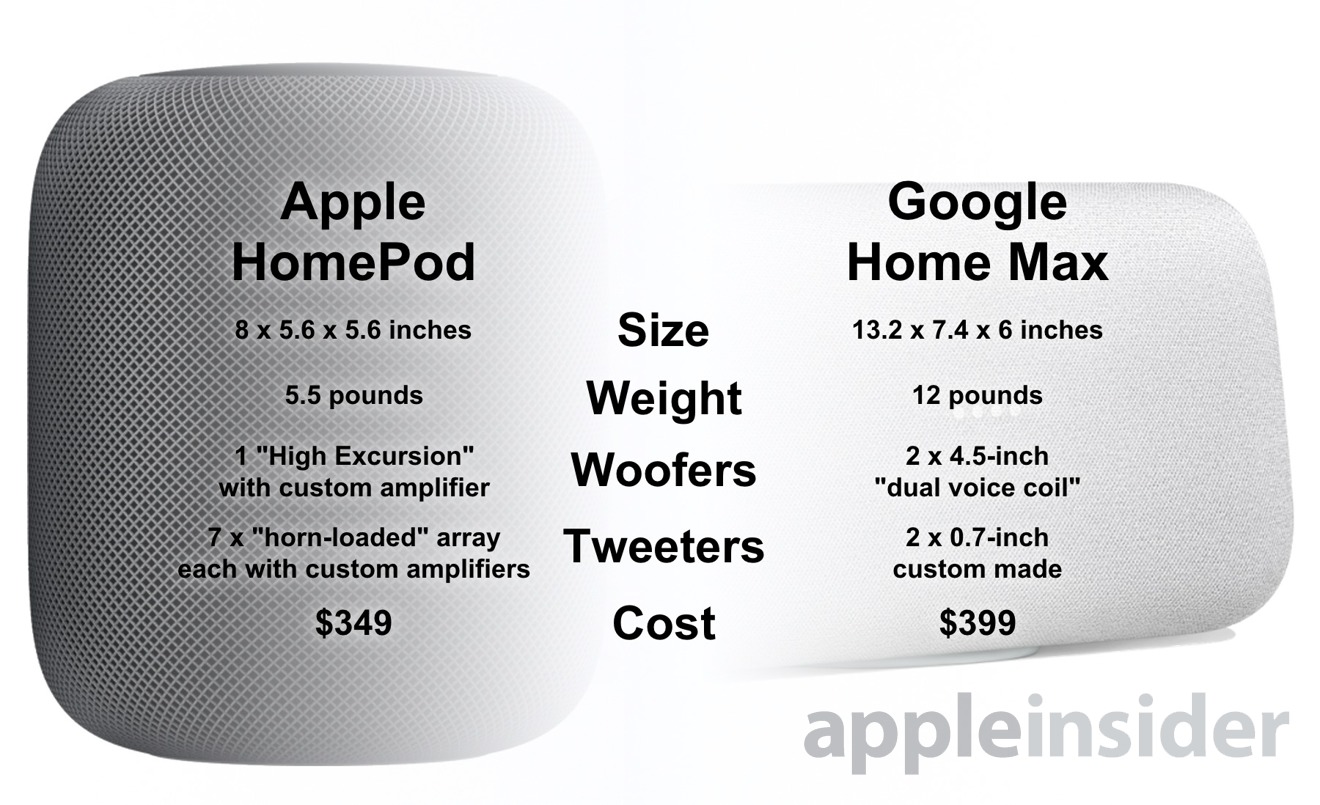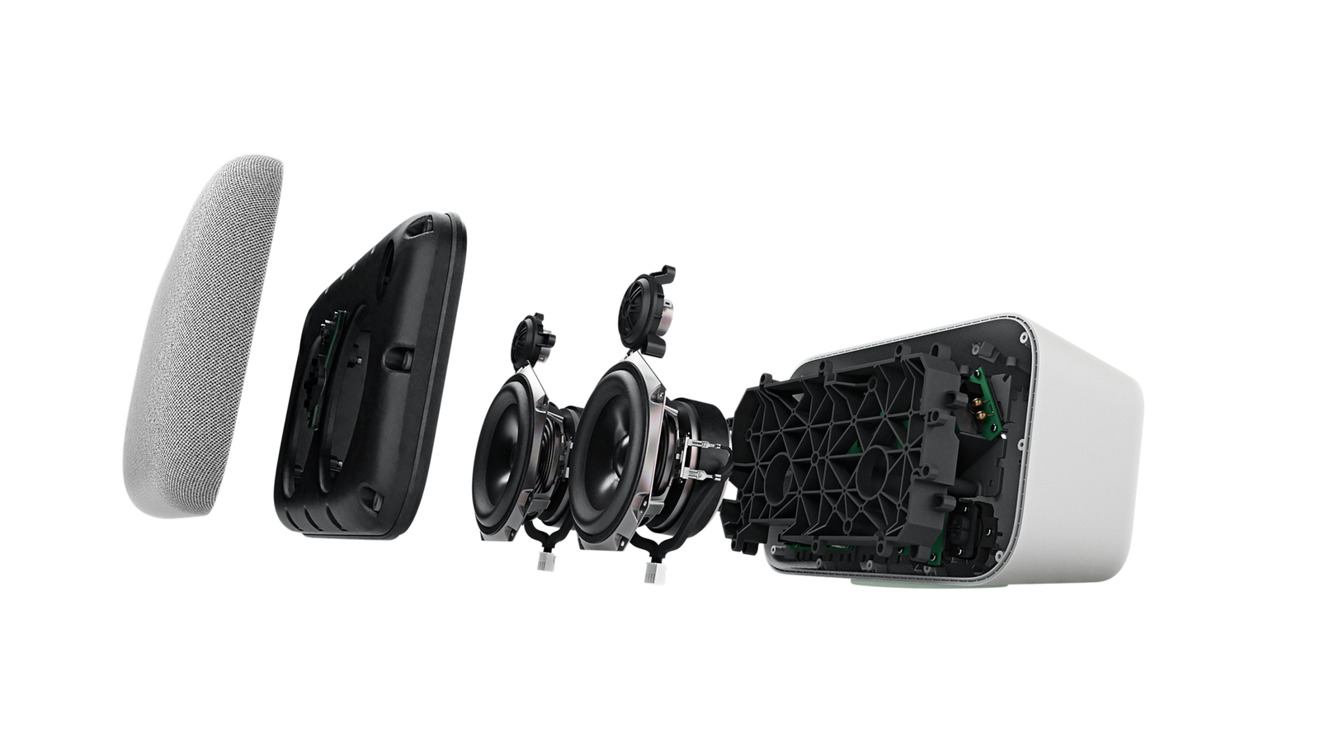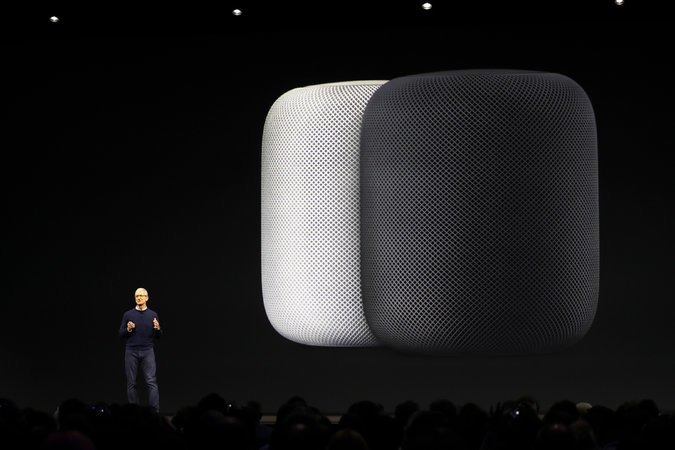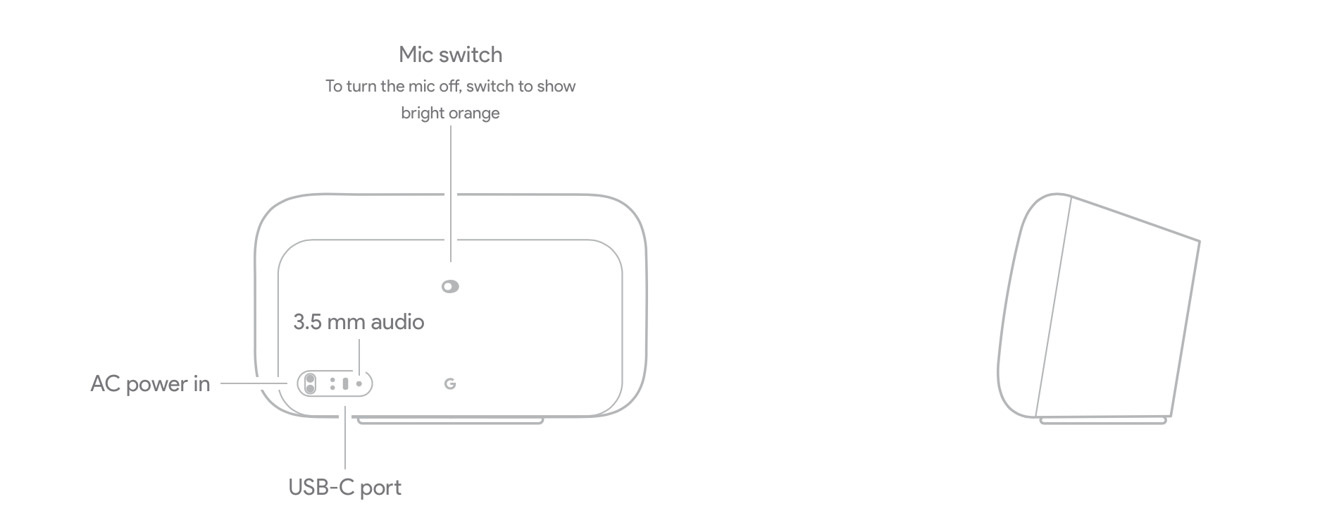While the $399 Google Home Max and the $349 Apple HomePod are roughly aiming for the same market, both have taken very different approaches. AppleInsider compares the hardware, and delves into which speaker might work the best for you.
Google Home Max versus the HomePod, on paper
We have the advantage of the Google Home Max already being "out in the wild," so to speak. Reviewers have been beating on it for a month now and, as you might expect, they have opinions.
Generally, the impressions are good. The device is noted for its sound quality, with a punchy bass. It has been criticized for still needing audio settings adjustment after being moved, despite claims of it having a "smart sound" feature for audio adjustment depending on positioning.
The Google Home Max, at 13.2 x 7.4 x 6 inches, is larger than the HomePod at 6.8 inches high, by 5.6 inches wide. In theory, this allows for a larger chamber volume for the Home Max, improving the physics of sound — but looking at the cutaway of the device, there's just not a lot of speaker volume for the enclosure.
Apple's HomePod is less than half the weight of the Home Max, at 5.5 pounds. Google's offering exceeds 12 pounds, and has been called awkward or bulky by more than one reviewer.
Connectivity for both is provided by Wi-Fi. The Google Home Max adds a 3.5mm jack, and a USB-C port. The Google Home Max uses it's Cast technology to push audio to it, where Apple, naturally, uses AirPlay — with AirPlay 2 coming "later this year, presumably when iOS 11.3 launches to the public.
Audio codec support is equivalent between the two devices, with Apple finally embracing FLAC in the HomePod, at least in part.
Two 4.5-inch dual voice-coil woofers are on the Google Home Max, supported by two 0.7-in "custom tweeters," according to the company.
Apple has gone with a "high-excursion woofer with custom amplifier" and an "array of seven horn-loaded tweeters, each with its own custom amplifier." Boosting that, there are low-frequency calibration microphones for bass correction, beamforming to adjust to the size and composition of the space, and "transparent studio-level dynamic processing."
Digging past the buzzwords and tricky phrases, Apple has gone with a system that can conform to a space better. The horn-loaded tweeters fire independently of each other with the custom amplifiers dedicated to each one, with the A8 controlling the audio from the array on-the-fly for the best possible sound that the track can deliver.
Apple's beamforming inclusion on the HomePod has riled up the audiophile community a bit — they remain surprised at how the technology normally limited to super-high end equipment is on a $350 consumer-level device. It's not clear if the layman will get much from that, but as with any sound quality assessment, it greatly varies from person to person.
Google hasn't gone into much detail on its microphones. Apple, however, has, with the HomePod having a six microphone array for far-field Siri. Given that the HomePod is designed to be plunked anywhere in the space, while the Google Home Max is really intended to go up against a wall, it's not clear how much difference this makes in the real world.
The Home Max has the ability to play multi-room audio and multiple units can be paired for stereo pairing now — but, as with AirPlay 2 support, we have to wait for it for the HomePod.
Not yet an audio Thunderdome
Audio quality is not just a function of hardware slapped together. We're not going to declare a winner, here, as we don't have a HomePod to listen to — but there are clearly prime candidates for either device based on other factors.
All of the reviewers of the Google Home Max say that the sound quality is excellent — and for a $400 speaker, that had better be the case. But, Google Assistant integration without it being your major driver on your smartphone is problematic, and not fully baked.
Apple is unapologetic about Siri being lobotomized for the HomePod — for now. But, by itself, and without handing off to a tethered device, Apple Music subscribers can play just about anything they want on the HomePod without "pushing" the music from a device.
HomePod connectivity will open up a bit when AirPlay 2 support comes to the device. But, that day is not today, and is a nebulous "later this year." The same goes for pairing to HomePods for stereo — but it can be argued that if you're looking at doling out the cash for a pair of HomePods or Google Home Max devices for stereo pairing, it's time to look into receiver and speaker setups.
So, the Google Home Max is shooting at those fully bought into the Mountain View search engine's way of life. The same with the HomePod. Pick your walled garden — the only difference is the height of the wall, be it four-foot or six.
So, which?
This is the part where you expect AppleInsider to dive in and wholeheartedly recommend the HomePod as the one speaker to rule them all. But, we're not going to — and we're not going to declare Google's offering the ultimate winner, either.
For most of us, we use Apple products not as a religion, but as the right tool for the job. Cupertino's paladins will choose as they always do, and so will the Google devout.
What remains is the rest of us, making decisions about what will work the best with our devices. In this case, with sound quality being as subjective as it is and dependent on literally hundreds of factors and not all of them controllable by the speaker hardware itself, it comes down to the other features of the devices in question.
The Google Home Max has other inputs, to allow users to, say, plug in an iPhone 6s through a headphone jack and make a rudimentary Siri-powered smart speaker with a Google label. The converse is not true — connecting your Android phone to the HomePod with a cable just isn't going to happen.
That all said, the HomePod is the ultimate choice for the Apple Music subscriber. Don't even bother looking elsewhere unless you're looking at stereo separation not relying on bouncing the audio off walls, where things get a little murky when you throw receivers into the mix at that price point.
But, like we said, the choice is less clear-cut if you're platform agnostic. We recommend a side-by-side listening when the HomePod ships, if you can wrangle it.
Hearts and minds
Google is looking for a further toe-hold in houses with the Home Max, another set of ears for Google to use to listen to its users. Whether you think that's for good or for evil is up to you. Apple couldn't care less about that, and will happily skim the cream off the top of the market the same way it seizes the majority of the smartphone industry's profits, or take a bit more cash from the Apple faithful fully bought into its services and ecosystem.
Based on assessments of the HomePod by audiophile communities, the HomePod looks to have jammed a great deal of high-end technology found in thousand-dollar boutique systems into a consumer-priced device. Whether or not Apple's choices pan out in real life remain to be seen.
But, both the HomePod, and the Google Home Max sit in a difficult position. They're both trying to convince smartphone users who have historically listened to music on earbuds that they want to dole out $350 or $400 for a single speaker to listen, now.
When the iPod launched, on this very website's forums, there were complainers that they didn't see how it fit into Apple's vision, or how they would use it. For most of us, author included, it took using one for a few hours to push us over the edge.
We suspect that the HomePod, and the Google Home Max, are facing a similar challenge, and only time will ultimately tell how well they do — but we're not worried about the fate of either company because of it. Neither the HomePod nor the Google Home Max are products that were designed to make one ecosystem more appealing than the other, but we're glad they both exist.
 Mike Wuerthele
Mike Wuerthele






-m.jpg)






 Andrew O'Hara
Andrew O'Hara
 Wesley Hilliard
Wesley Hilliard

 Malcolm Owen
Malcolm Owen
 Marko Zivkovic
Marko Zivkovic

 Chip Loder
Chip Loder
 Christine McKee
Christine McKee




-m.jpg)




36 Comments
Some testers on YouTube confirmed that Sonos Play:3 or even 2 Sonos One blew the HomeMax out of water. HomeMax got sound distortion at high volume.
If I was choosing one it would obviously be the HomePod, just like probably everyone on this website, but still not sure I need one yet.
I have an old LG 1woofer/2tweeter system plugged into my Mac @ home. Not sure how big the woofer is, but I'm sure HomePod will blow it away. Still works fine for now though, but when it finally croaks the Google system will not be on my list.
Edit: PS can't wait for the iFixit teardown!
A nice, balanced run down of the units and oozing common sense. Well done!